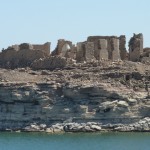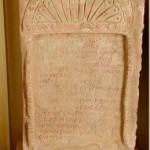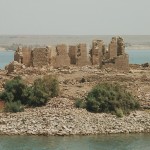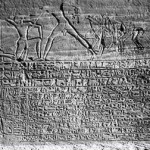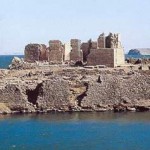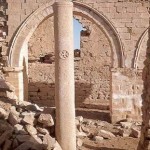Qasr Ibrim (Arabic: قصر ابريم) is an archaeological site in Lower Nubia. It was originally a major city perched on a cliff above the Nile, but the flooding of Lake Nasser after the construction of the Aswan High Dam transformed it into an island and flooded its outskirts. Qasr Ibrim is the only major archaeological site in Lower Nubia to have survived the Nile floods. Both prior to and after the Nile floods, it has remained a major site for archaeological investigations. Human habitation at the site dates from the Late Kingdom, but it reached its greatest prominence in the Middle Ages, when the area was the home of the Eparch of Nobatia. Qasr Ibrim is the source of the largest collection of Old Nubian documents ever found, including the records of the Eparch. The site was inhabited until the 1840s. Today the island is closed to all but archaeologists.
This important site derives its name from the nearby village of Ibrim, on the east bank of the Nile. Wasr Ibrim is also notable for its fortress of Qasr Ibrim (“The Castle of Ibrim”), which certainly stood on older pharaonic foundations. Partly built “in Roman times under the prefecture of Gaius Petronius during Augustus’ reign,” it was originally a pharaonic site with material from the New Kingdom and later periods of Egyptian history being found here. This is established by reused and isolated monuments from this older period: the earliest record is a dated Year 8 stela of Amenhotep I while “a temple structure of Taharqa (with a painting showing the king offering to a god)” is also known here.
The stela was found in a now ruined Christian Byzantine cathedral now at Qasr Ibrim where it had been reused in one of the church’s crypts and is now located in the British Museum.In the west slope of the fortress hill, there existed several “rock-cut memorial chapels dedicated by various Viceroys of Kush to New Kingdom rulers and various deities.”During the salvage operations carried out when the Aswan dam was being constructed, “their reliefs were cut away and removed to the vicinity of New Wadi es-Sebua. A large rock stela of Seti I with his serving viceroy of Kush Amenemope which used to be [located] south of the fortress of Qasr Ibrim were transferred to the neighbourhood of New Kalabsha at Aswan.
The site was visited by early travellors and was first excavated by David Randall-MacIver and C. Leonard Woolley for the Eckley B. Coxe Expedition for the University of Pennsylvania in 1911.


